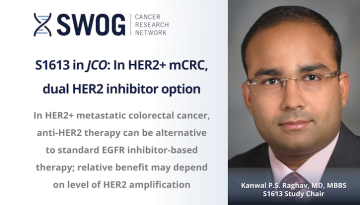Previews of Our Next Best of SWOG Webinar
In an earlier Front Line, I provided titles of the 22 SWOG oral presentations, poster discussions, and posters our members would be involved with (in a major way) at the ASCO 2022 annual meeting that starts today in Chicago.
This week I get the pleasure of revealing actual results, and the privilege of offering you a chance to see some of these findings presented by the lead authors themselves in an upcoming “Best of SWOG at ASCO” webinar.
I’ll host the one-hour webinar on June 29, 2 pm ET/11 am PT. You’ll be able to ask questions via the chat box, in real time. We’ll have a lot of great content to cover, so presentations will be rapid-fire. Expect an email invitation soon that will include a link to pre-register for the event.
Here are summaries of a few of the most notable SWOG results that will be delivered at ASCO and in our June 29th webinar. We’ve issued press releases on these results (and a couple of others I’ll share next week), so click through from any of the paragraphs below to learn more.
- Desmoplastic melanoma typically appears on sun-exposed areas such as the face, neck, and scalp. Treatment – generally, surgery with wide excision margins followed by radiation therapy – often leaves patients with prominent scars in highly visible areas. Building on earlier research suggesting these tumors might respond to PD-1 blockade, Dr. Kari Kendra of The Ohio State University Comprehensive Cancer Center and Wexner Medical Center led a team that hypothesized that neoadjuvant PD-1 blockade therapy could lead to patients needing less extensive – and less disfiguring – surgery and radiation. In SWOG S1512, they tested this approach with pembrolizumab in 29 patients. In 16 of those patients, tumors showed a pathologic complete response to the immunotherapy. While the trial did not specifically assess the subsequent surgery, the responses seen in many patients suggest such neoadjuvant immunotherapy could often reduce the extent of surgery these patients would need.
- Febrile neutropenia (FN) can be a serious side effect of chemotherapy, but medical guidelines recommending when to use colony-stimulating factors (CSFs) to prevent FN are often not followed. The cancer care delivery trial S1415CD (a.k.a. TrACER) tested whether an intervention could improve guideline adherence (and lower the rate of FN) – it added standing physician orders to electronic medical records systems to guide prophylactic prescribing of CSFs. The trial team, led by Dr. Scott Ramsey of the Fred Hutchinson Cancer Center and Dr. Dawn Hershman of Columbia University (both of whom have S1415CD abstracts at ASCO), cluster-randomized a group of NCORP sites, assigning some clinics to use the standing orders and others to continue usual practice. They found that for patients on high-risk chemo regimens or low-risk regimens, the intervention had little effect on prescribing practice. And while the intervention did significantly improve adherence in prescribing for patients on intermediate-risk regimens, it did not significantly reduce the rate of febrile neutropenia in any of these three groups of patients.
- Patients with muscle-invasive bladder cancer often receive chemotherapy before their surgery, but many see little benefit from it. Having an easy-to-test biomarker to predict which patients are likely to respond could save many from a difficult course of neoadjuvant chemo. Dr. Amir Goldkorn of the USC Norris Comprehensive Cancer Center led a correlative study within the S1314 trial that may have identified just such a biomarker. By analyzing methylation patterns in cell-free DNA extracted from plasma samples, Goldkorn’s team developed a response score that, when combined with additional data, could correctly predict tumor response in 79 percent of the patients they had tested. If validated, this approach could help doctors better assess whether a patient with muscle-invasive bladder cancer should get neoadjuvant chemo.
- The Affordable Care Act’s expansion of the Medicaid program starting in 2014 significantly increased usage of Medicaid insurance. It hasn’t been clear, though, whether this increase translated to increased participation in clinical trials by patients covered by Medicaid. Now a team led by Dr. Joe Unger of SWOG’s Statistics and Data Management Center and the Fred Hutchinson Cancer Center has answered that question at least for SWOG clinical trials: yes, Medicaid expansion significantly increased the proportion of SWOG trial participants covered by the insurance program. The team’s analysis estimates that, had the Medicaid program not been expanded, 7.4 percent of SWOG trial participants would have been covered by Medicaid insurance in February 2020. Instead, the actual percentage covered by Medicaid in February 2020 was 20.8 percent, an almost threefold increase over what would have been expected. The findings suggest that the Medicaid expansion has made clinical trials more accessible to more vulnerable patients.
Next week I’ll highlight more SWOG results, including positive findings for some patients with non-small cell lung cancer and for others with high-risk renal cell carcinoma.
Mark our Best of SWOG at ASCO webinar on your calendar now: June 29, 2 pm ET/11 am PT. And watch your email for our invitation so you can pre-register!
Other Recent Stories



